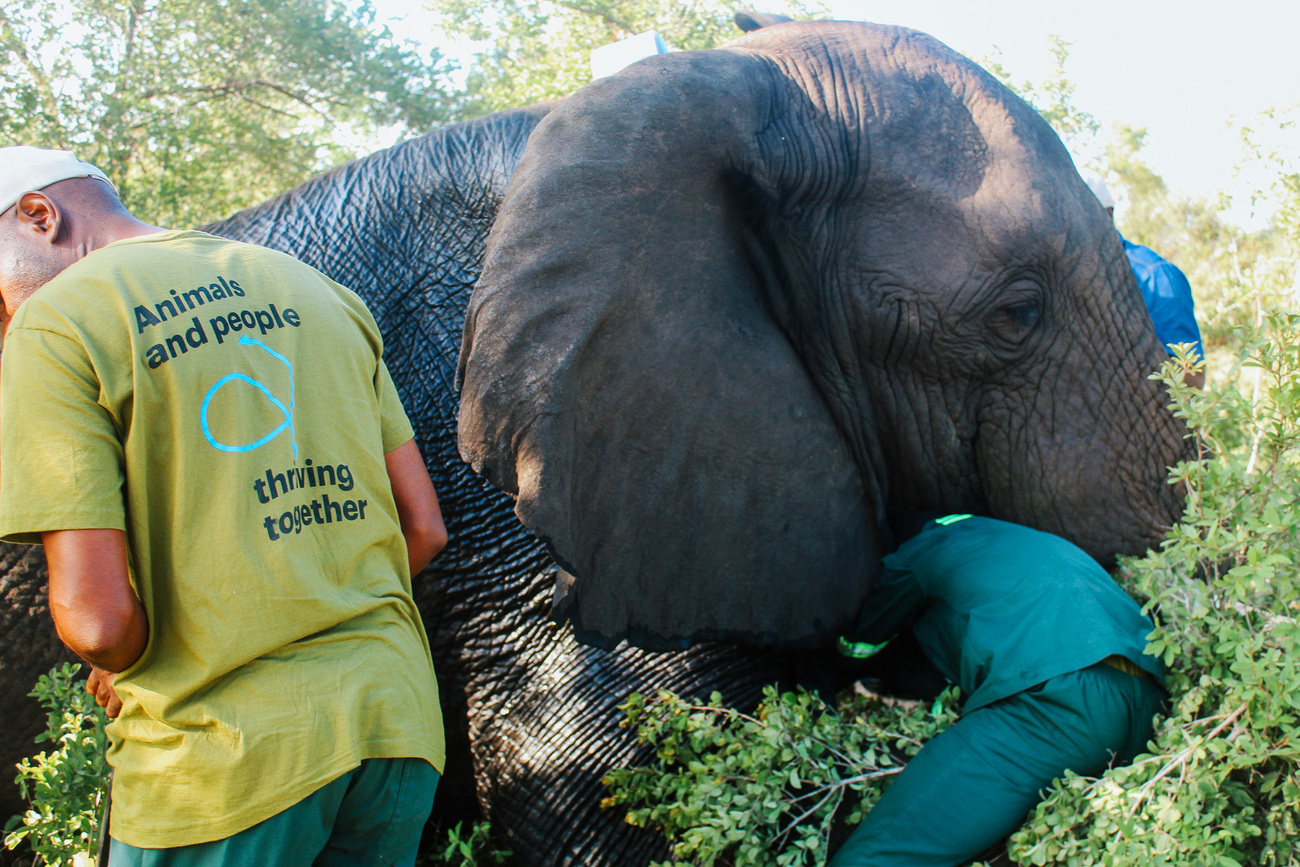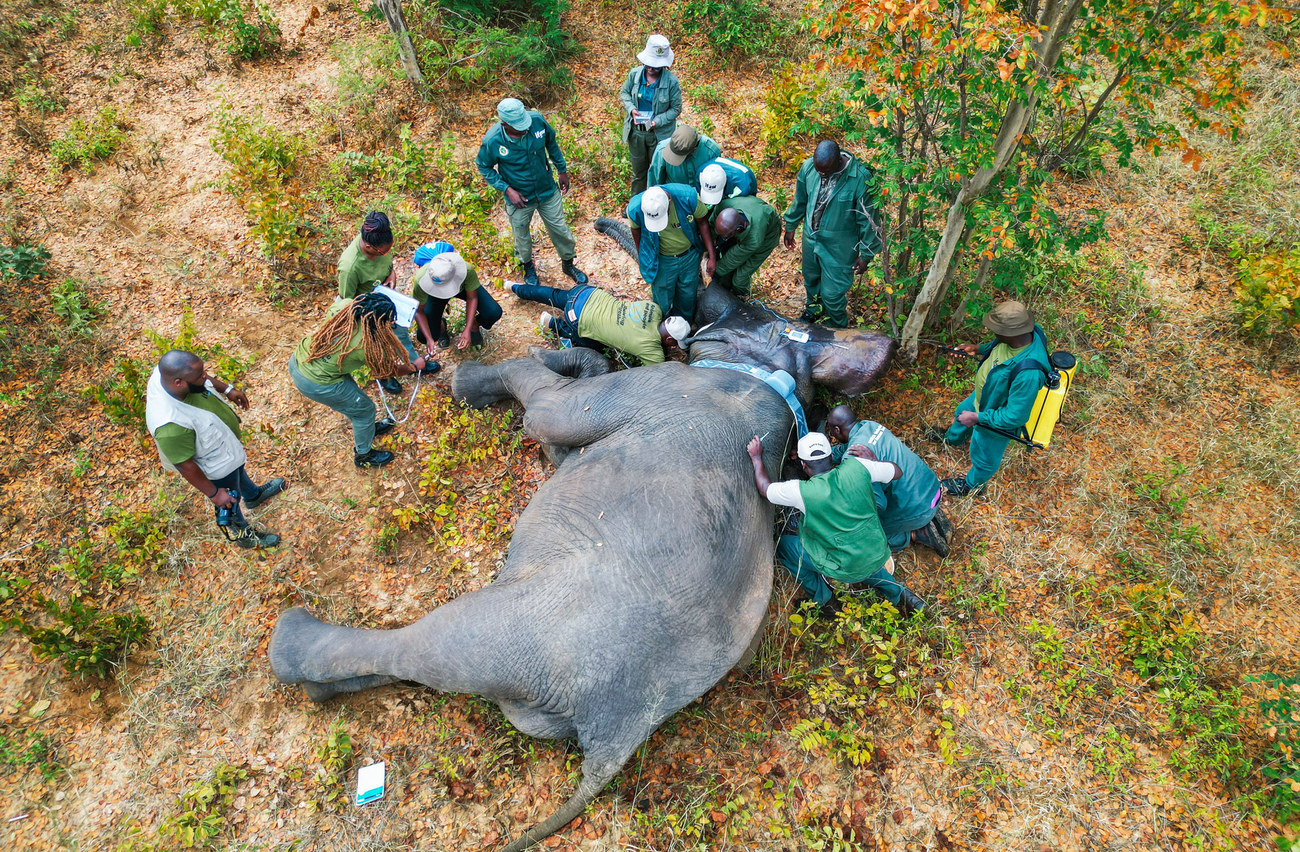Henry Ndaimani
GPS collars protect elephants and people on the outskirts of one of Africa’s largest parks
GPS collars protect elephants and people on the outskirts of one of Africa’s largest parks
In April, a team of IFAW experts and ZimParks participated in a high-stakes elephant collaring operation on the edge of Hwange National Park—one of Africa’s ten largest national parks and a stronghold for the world’s largest land animal.
Their mission was to fit GPS-enabled collars to eight African savannah elephants, a process that would yield invaluable data. Once gathered, this data would offer key information about how elephants move in the human-dominated settlements bordering Hwange National Park. Knowing how they move through the area is a critical first step toward safeguarding these majestic animals and fostering harmonious coexistence with local communities.

As the team completed their preparations under the scorching Hwange sun, a herd of elephants led by a formidable matriarch appeared from the thicket, capturing the crew's attention. After carefully choosing their target for collaring and taking all necessary safety measures, they administered a tranquiliser dart.
Slowly, the four-tonne giant experienced the effects of the drug, allowing the crew to move swiftly into action.
With a narrow window of approximately 20 minutes (to minimise the time the elephant was sedated), the team executed their task with the utmost care. They precisely fitted the GPS device, measured the animal, and took all the necessary blood samples.
After administering a reversal shot, the team watched from a safe distance in silent awe as the collared matriarch, seemingly unaffected by the recent events, rose, assessed her surroundings, and rejoined the herd.
‘Each collaring operation is unique, and you cannot anticipate how an elephant will react,’ says veterinary doctor Kudzai Mupondi. ‘However, seeing an elephant get back on its feet and roam once again is always a great sense of satisfaction.’
Over a period of 15 days, the crew safely collared all eight targeted elephants—four matriarchs and four bulls—without causing harm to the animals or the crew. Collaring female elephants in breeding herds, who are usually the leaders of their family groups, is especially useful—by collaring one matriarch, we can monitor the entire herd that follows her.
Harnessing technology to promote peaceful coexistence
Zimbabwe has an elephant population of approximately 100,000, the second largest in the world after Botswana. Almost half the country’s elephant population resides in the Hwange–Matetsi–Zambezi landscape, which is considered a hotspot for human-elephant conflict due to crop-raiding elephants that threaten the livelihoods of subsistence farmers.
Human-elephant conflict is a perennial risk that has intensified over the years, as elephants have been forced to move closer to communities in search of food and water due to habitat loss from human population growth, agricultural expansion, infrastructure development, and climate change.
To better understand elephant movements on the park’s outskirts and help promote peaceful coexistence in the greater Hwange ecosystem, IFAW collaborated with ZimParks on the recent two-week-long elephant collaring operation. Over the years, technology has revolutionised elephant conservation in Africa, and we have to embrace technology as a powerful ally in the protection of these magnificent creatures.
Collaring plays an important role in conservation as it helps monitor the movements of elephants, track their migration patterns, and identify potential threats such as poaching or human-wildlife conflicts—all of which enables us safeguard their important migration routes and ensure the long-term survival of elephant populations as part of IFAW’s Room to Roam initiative.
ZimParks and IFAW will use GPS or radio frequency identification to create virtual fences, also known as geo-fences. When a collared elephant approaches the virtual fence or is about to approach human settlements, the collar will send a message in near-real time to an elephant monitoring dashboard. This will allow rangers or community guardians to respond before any conflict or crop damage occurs.

How to collar elephants
Elephant collaring is a challenging operation that requires extensive expertise and skill; there is no room for error. Here’s a glimpse into how it is done.
1. Darting the animal with an anesthetic
Once a suitable animal has been located in the field, the person responsible for handling the immobilisation drugs prepares a dart with enough drugs to take down the animal. The amount depends on the animal’s estimated weight. Ideally, a smaller group of people then carefully approaches the target animal to get within 30 metres of it.
The dart is usually administered on the backside of the animal to enable retrieval once the animal goes down. After the dart is administered, it takes about 10 minutes for the animal to go down. The easiest scenario is when the darted animal does not panic and remains in the same place.
‘This is a critical stage of the collaring exercise, and we have to monitor the elephant’s vitals closely throughout the sedation process to ensure the animal’s safety,’ says Dr. Mupondi. ‘As we conduct the collaring operation, the safety of the animal is our top priority.’
2. Keeping the other elephants away
After successfully darting an elephant, the team then needs to encourage the other elephants in the target herd to move away so they don’t interfere with the collaring. This can be a challenging task, especially when the matriarch is darted. Other elephants tend to stick together and won’t move away easily. The team needs to make noises to scare them off. In certain circumstances, some elephants may not move away at all. This task is easier when dealing with bulls and solitary animals—bulls tend to easily move away from an immobilised colleague at the slightest provocation.
3. Fitting the collar
Once the other elephants have been scared away, the rest of the collaring team quickly moves in to install the collar as soon as possible to minimise the stress for the elephant.
Part of the team works on cooling down the immobilised animal using a knapsack spray, while others monitor breathing and pulse. If necessary, some team members take measurements like shoulder height, body length, and tusk sizes to profile the elephant. Meanwhile, the team responsible for fitting the collar takes a measurement of the neck size, fits the collar, and cuts excess belt length, properly positioning the collar for best transmission. The collar is not tightly fitted to leave room for the animal to grow.
When all these steps have been successfully completed, the team moves out to a safe distance before a reversal drug is administered. The collared elephant is revived and ready to move away and join the rest of the herd.
‘Once the task is successfully executed, we then have also to consider post-collaring care,’ says Dr. Mupondi. ‘Monitoring the collared elephant is critical, and we are always there to attend to any discomfort or other issues that may arise.’
Related content
Our work can’t get done without you. Please give what you can to help animals thrive.